How to Stop Your Dog From Chewing Your Stuff
- Anja Boecker
- Updated: 2023-08-21
Once you're out of the house, nothing is safe from your dog's teeth. Your pet will nibble on anything: chair legs, slippers, your favorite sofa, and even his own paw. Learn what causes nibbling in puppies and adult dogs and what you can do about it.
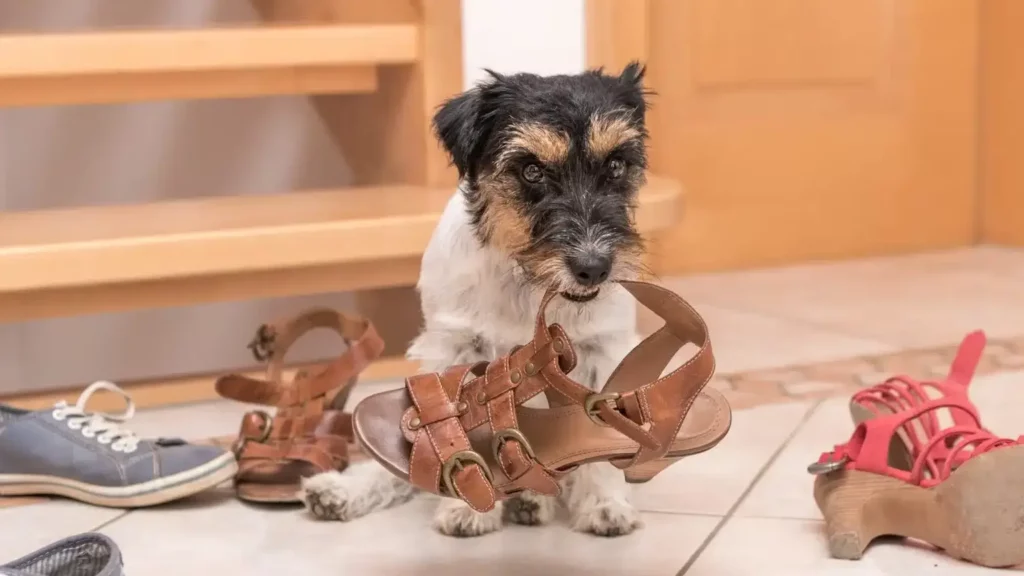
Dogs have a need to chew. Nibbling and chewing is part of your dog's normal behavior. But chewing is not only annoying, it can be dangerous for your dog. This is especially true if he picks up pieces of food or swallows objects that can cause injury.
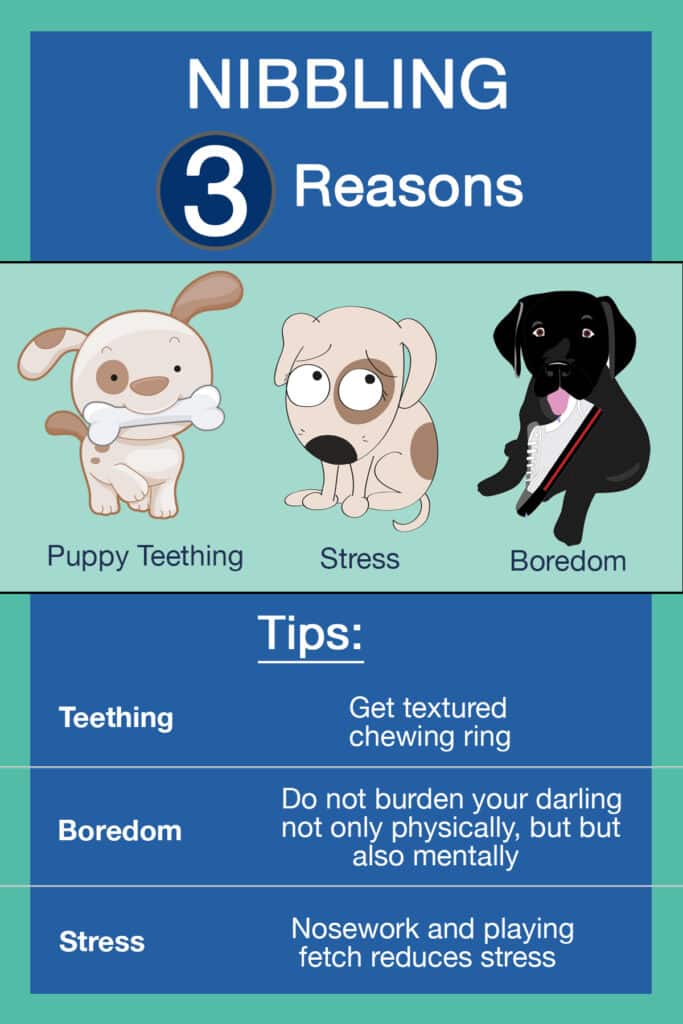
What Exactly Is Behind It?
Dog owners know this: You turn around for a second and your beloved four-legged friend has already set its sights on the latest magazine, the child's favorite toy, or even the expensive sofa.
Nibbling, gnawing, biting - why is my dog doing it and what can I do about it? Let's dive into the world of chewing together and find solutions.
First, let's look at the possible reasons for nibbling. Is your dog a puppy? Or do you have an adult dog? This plays a big role in determining the cause.
There are many reasons why dogs chew. It can be a sign of boredom, stress, a puppy's teething, or even a health problem. It is important to determine the cause so you can take appropriate action.
5 Reasons:
- Puppy Stage: Puppies often use their mouths to explore the world. In addition, the change in teeth can cause itching in the mouth, so they like to chew on objects.
- Puberty: Dogs may also chew more during puberty due to hormonal changes.
- Boredom: An underachieving dog will often seek out activities to pass the time.
- Stress or Anxiety: Nibbling can also be an outlet for unprocessed emotions.
- Health Problems: Dental problems, nutritional deficiencies or other illnesses can also lead to increased nibbling.
Next Steps
Find Out the Cause: Before fixing the problem, try to find out why your dog is chewing. Is it boredom? Stress? Toothache or puppy teething? Or maybe a health problem?
Dogs often chew out of boredom and lack of exercise. Regular walks, games and activities can help burn off excess energy.
Invest in quality chew toys. This will give your dog a chance to satisfy his chewing instinct.
If you catch your dog chewing, gently distract him and offer him an acceptable alternative, such as his chew toy.
Consider basic training or dog school to teach your dog the basic commands. A well-trained dog is often a happier dog.
If you leave your dog home alone, make sure dangerous or valuable items are out of reach.
If your dog only nibbles when left alone, he may be suffering from separation anxiety. If this is the case, it may help to slowly increase the amount of time away and show him that you will always come back.
There are special defensive sprays that taste unpleasant but are harmless to the dog. These can be sprayed on objects that the dog likes to chew.
A visit to the veterinarian may be useful to rule out health issues such as dental problems or deficiencies.
If you can't get a handle on the problem, an experienced dog trainer can provide individualized solutions and tips.
Remember to praise positive behavior! If your dog chooses to chew on his toy instead of your shoe, praise him for it.
Patience is the key. With time and consistent training, your dog's nibbling behavior is sure to improve.
It is also important to understand that nibbling is a natural behavior of the dog and sometimes he just needs an appropriate way to satisfy this need.
Training Accessories
- High-quality chew toy
- Chewing bones or sticks
- Intelligent toys for employment
- Storage that is as inaccessible as possible for things that should not be nibbled on
Organic Causes
To be on the safe side, rule out organic causes. Have you noticed any changes in your dog's behavior? Talk to your veterinarian.
In summary, the causes of nibbling can be summarized as follows:
- Teething (for puppies)
- Loneliness or separation anxiety
- Boredom
- Organic diseases (such as a brain tumor)
Causes + Tips
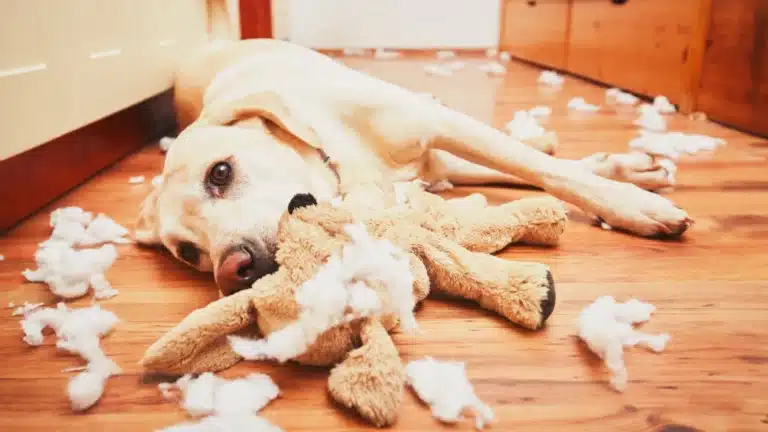
Once you've identified the cause of your pup's nibbling, it's easier to break the habit.
Your Puppy Chews on Everything?
Puppies are especially known for chewing on all sorts of things. Some of this behavior is normal as they explore their environment, and chewing is also a relief during teething.
When puppies nibble, they are probably in the process of teething. This occurs between the fourth and seventh months of life.
Maybe your new roommate's gums are itchy or he's in pain. He tries to get relief by nibbling.
Chewing massages the gums and helps loosen loose milk teeth.
However, it is important to guide this behavior in the right way to avoid harm and potential danger to your puppy. Here are some tips on how to help your puppy chew properly:
Tip 1 - Provide Chew Toys
If your puppy is teething, he's probably trying to get rid of loose teeth. Give him natural rubber chew toys or a chew bone. Make sure your puppy has a variety of chew toys to choose from. These will satisfy his natural chewing instincts and distract him from unwanted objects.
Tip 2 - Correct Unwanted Chewing
If you catch your puppy nibbling on something he shouldn't be nibbling on, politely say "no" and offer an appropriate alternative, such as a chew toy.
Tip 3 - Bitter Sprays
There are non-toxic sprays with a bitter taste that can be sprayed on objects to make them unattractive to the puppy.
Tip 4 - Puppy Safe Home
Puppies are curious and will explore. Keep dangerous or valuable items away from them.
Tip 5 - Consider Changing Teeth
Puppies are going through a change in their teeth, which can be uncomfortable. Cool chew toys can provide relief. This helps with itchy gums. If you chill the toy first, it will help ease the pain. Chewing can also distract your pet.
Tip 6 - Get Enough Exercise
A tired puppy is often a happy puppy. Plenty of exercise and play will help burn off excess energy.
Tip 7 - Training
Start early with some simple training. This will foster a bond between you and your puppy while teaching him what he can and can't do.
Tip 8 - Praise
Every time your puppy chooses the right chew or hears a "no," praise him. Positive reinforcement works wonders.
Tip 9 - Be Patient and Consistent
Puppies are like little children and need clear, consistent instructions and lots of patience.
Tip 10 - Socialization
Good socialization can help build your puppy's confidence and reduce undesirable behaviors. As soon as his vaccination status allows, he should play with other dogs and explore new environments.
Tip 11 - Council
If the nibbling doesn't stop despite your best efforts, or if you suspect there is an underlying problem, you should consult a dog trainer or behaviorist.
Remember that puppies are naturally curious and explore their world with their mouths. With love, patience and proper training, your puppy will learn what he can and cannot chew.
Is Your Dog Going Through Puberty?
Is your little rascal in the midst of puberty? He may be bursting with energy and underchallenged in his daily routine.
When your dog reaches puberty, it can bring many behavioral changes.
Hormonal changes, a greater need for independence, and testing of boundaries can be typical during this stage. Here are some tips for dealing with an adolescent dog who nibbles at everything:
Tip 1 - Show Understanding
First, it's important to understand that puberty is a natural part of your dog's life. Like humans, dogs can be particularly stubborn and rebellious during this time.
Tip 2 - Consistency Is Key
During this phase the dog often tests his limits. Therefore, be especially consistent in your training. This does not mean that you should be strict, but that you must be clear and unambiguous in your commands and responses.
Tip 3 - Employment
An adolescent dog often has a lot of energy. Provide plenty of exercise and mental stimulation. This can be accomplished through long walks, games, or training sessions.
Tip 4 - Chew Toys
Make sure your dog has plenty of appropriate chew toys. This will help direct his chewing instinct in the right direction.
Tip 5 - Keep Training
Even if it seems like your dog has forgotten everything you taught him, continue training. Repeat the commands you have already learned and incorporate new ones.
Tip 6 - Rest Periods
Like puppies, dogs need adequate rest during adolescence. Fatigue can lead to undesirable behavior.
Tip 7 - Socialization
Regular interaction with other dogs can help to release excess energy and strengthen social skills.
Tip 8 - Consider Consulting
If the behavior becomes particularly challenging, it may be wise to consult a dog trainer or behaviorist.
Tip 9 - Praise
Reinforcement is especially important. When your dog exhibits the desired behavior, praise him profusely.
Tip 10 - Physical Separation
If you can't supervise your dog, consider leaving it in a safe room or area where it can't do harm.
Tip 11 - Health Check
It doesn't hurt to see a veterinarian to make sure the chewing isn't due to a health problem.
Puberty can be challenging for dog owners, but with patience, understanding, and consistent training, you and your dog can successfully navigate this stage.
Remember that this is only a temporary stage, and with your help, your dog will grow into a well-adjusted adult.
Loneliness and Separation Anxiety
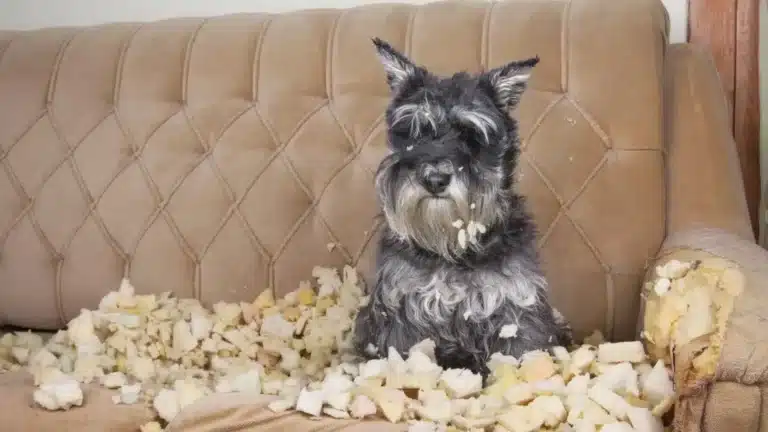
Or maybe your furry friend just doesn't want to stay home alone. Loneliness and separation anxiety are common in pets.
Dogs are pack animals. They need social interaction. Your pet may be frightened or distressed because you're not around. Separation stress is a common reason for a dog to tamper with your home's furnishings.
If a dog only chews when left alone, there may be several reasons for this.
The most common cause is separation anxiety. The dog misses its owner and becomes restless or stressed. Nibbling is a way to relieve the stress.
Tip 1 - Slow Familiarization
Slowly acclimate your dog to being alone. Start with a few minutes and slowly increase the time. Every time you come home and everything is fine, praise your dog.
Tip 2 - Keep Him Busy
Before you go out, make sure your dog has something to do. A long walk or a game can help him burn off excess energy, making it easier for him to calm down when he's alone.
Tip 3 - Intelligence Toys
There are toys that challenge the dog mentally. For example, cones that can be filled with treats or wet food. This will keep your dog occupied while you're away.
Tip 4 - Safe Environment
Make sure your dog doesn't have access to things he might destroy. A separate area or room may help.
Tip 5 - Sedative
There are special pheromone sprays or misters (e.g. Adaptil) that can have a calming effect on dogs.
Tip 6 - Music or Audio Books
Some dogs find it soothing to have soft music or an audio book playing in the background. This can help alleviate feelings of loneliness.
Tip 7 - Webcams
Consider installing a webcam to observe your dog's behavior when you are away. This can help you understand what exactly is happening and if there are any triggers.
Tip 8 - Daycare or Dog Sitter
If your dog really can't be left alone, consider doggy daycare or hiring a dog sitter to take care of him while you're away.
Tip 9 - Dog Trainer or Pet Psychologist
In severe cases of separation anxiety, it may be wise to consult a professional.
Tip 10 - No Penalties
Even if you come home and find a "surprise", do not punish your dog. He will not understand why he is being punished, and this may increase his anxiety.
Tip 11 - Patience, understanding and consistency are the keys to success
Remember that your dog is not acting out of spite, but out of insecurity or fear. With proper support and training, the behavior can improve over time.
Training Your Dog to Stay Alone
To help your dog get used to being home without you sometimes, there is a simple training option:
Intentionally leave your puppy or adult pet alone. Start with a short period of five minutes. If this works well, increase the length of your absence.
Your dog should know that you will always come back to him. Regular training will help him get used to it.
If you want to know what your pet is doing while you are away, whether he is relaxed or restless, you can install a baby monitor or camera.
Don’t Make a Fuss Coming and Going.
When you leave, don't say goodbye to your dog effusively. When you come back, don't say hello. Just act like it's no big deal.
This will make it easier for your dog to accept you leaving the house. Your leaving and returning will become normal to him.
Turn on the TV
These sounds drown out the street noise. Many dogs relax to the familiar sound of the TV or something on YouTube on the side. Why not try a special dog video?
Is all this too theoretical for you? If you want to learn more, check out our App and join the course: Staying Alone.
Dog Boredom
Boredom may also be behind the nibbling. Your pet may be looking for something stimulating to do. You are not home. So he passes the time until you return.
But what can you do to help your dog? Here are some suggestions:
Walks, Dog Sports, and Training School
Is your dog a bundle of energy? Maybe you can take him for a run before work. Or spend your lunch hour with him. Biking is also fun for many dogs and really gets them going.
Try to incorporate as much exercise as possible into your dog's daily routine. The amount of exercise should be appropriate for your dog's age and health. If he is older, a walk may be enough to keep him physically active.
If you don't have the time to take your four-legged friend for a walk, exercise, or go to dog training school, another family member may be able to take over. Or a dog sitter.
Dogs also want to be challenged and stimulated mentally. How about agility training? This is where the dog has to navigate a course with obstacles according to set rules. You can also use clicker training to teach your pet tricks.
In the end, there is one thing behind all these ideas: Your dog needs a varied and exciting daily routine. He doesn't want to lie in the corner, sleep, and wait for you to come home. Your furry friend wants to move, discover the world and explore with all his senses.
Give your pet the opportunity to learn and grow. Then he will leave your furniture alone.
Offer Exciting Opportunities for Activity
There are a variety of smart toys and Kongs available in stores that can be loaded with treats. Or how about a sniffing rug?
At least it will keep your four-legged friend stimulated for a while. A variety of chew toys are available for fun and exercise.
A cozy sleeping basket should also not be missing as a place of retreat.
Your Dog Chews Furniture?
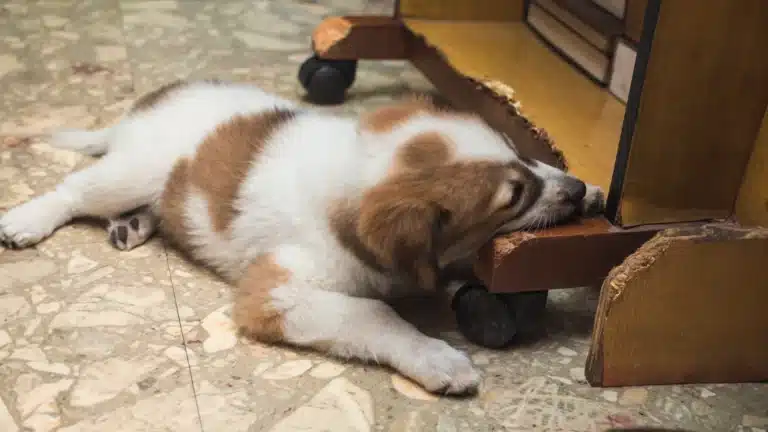
When your dog starts chewing on furniture, it can be frustrating and costly for you and your home.
This behavior may be triggered by boredom, stress, separation anxiety, or other factors. Fortunately, there are ways to deal with it:
First Aid and Home Remedies for Destruction
For now, you can use simple home remedies to make the chewing areas unattractive. This is a stopgap measure until dog training kicks in and your dog is better able to handle being left alone.
The most effective way to do this is to make the unwanted areas unattractive while providing your pet with alternatives to chew and nibble on.
Make Nibble Spots Unattractive or Remove Them
Attention: These home remedies will not solve the underlying problem. The important thing is to keep your dog mentally and physically active. Otherwise, sooner or later, your furry nose will find another outlet.
- Does your dog bite into table and chair legs? Rub the wood with vinegar. The smell is unpleasant for your pet, so hopefully he will stop chewing.
- Mustard often helps too. Coat a typical nibble site with it.
- Remove anything that could be chewed. Put your shoes in the closet. Hide cables in cable ducts. Put laundry in the closet. This will at least prevent your pet from tampering with it.
Your Dog Nibbles Paws?
There are several reasons why a dog may nibble on its paws. Here are some of the more common causes and solutions:
Allergies
Dogs can develop allergies to certain foods, environmental factors (such as pollen or dust mites) or chemicals (such as those found in cleaning products or flea and tick products). These allergies can cause itching, which can lead to chewing.
Solution: A veterinarian can perform allergy testing and make recommendations for a hypoallergenic diet or medications to relieve the itching.
Parasites
Fleas, mites or ticks can cause itching and discomfort.
Solution: Regular flea and tick prevention and a thorough examination of the paws and skin can help.
Dry Skin
Especially in the winter months, dry air can lead to dry skin.
Remedy: Special paw balms or ointments may help. Omega-3 fatty acid supplements may also support skin health.
Pain or Injury
An embedded thorn, cut or foreign object between the toes can cause pain and the need to nibble.
Solution: Carefully inspect the paw for visible injury and consult a veterinarian if in doubt.
Behavioral Disorders
Sometimes paw nibbling can be a behavioral disorder caused by boredom, stress, or anxiety.
Solution: Provide plenty of toys, exercise, and mental stimulation. If the behavior is severe, an animal behaviorist may be able to help.
Fungal or Bacterial Infections
Moisture and heat can encourage the growth of bacteria or fungi that cause itching.
Solution: A veterinarian can make a diagnosis and recommend appropriate treatment.
If you notice that your dog is nibbling his paws on a regular basis, it is always a good idea to consult your veterinarian. He or she can determine the exact cause and recommend appropriate treatment.
A proactive approach can help identify and treat potential health problems early.
Is It Natural for Your Dog to Chew On Everything?
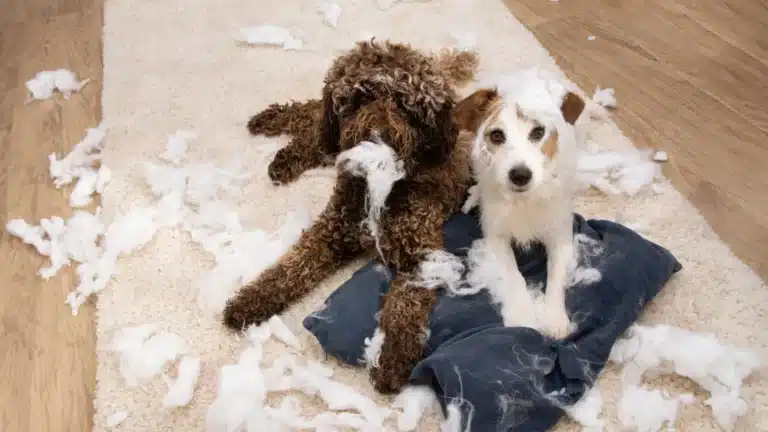
Yes, it is natural for dogs to nibble and chew on objects. There are several reasons for this behavior, as described above:
- Teeth Change in Puppies: Just like human babies, puppies go through a period of teething when their milk teeth are replaced by permanent teeth. This process can be uncomfortable and even painful. Chewing relieves the pain and helps the new teeth erupt more quickly.
- Explore the Environment: Dogs are naturally curious. They use their mouths to explore and learn about their environment. This is similar to small children putting things in their mouths to "explore".
- Boredom and Lack of Exercise: A bored dog will often look for ways to occupy itself, and chewing can be one of them.
- Stress or Anxiety: Sometimes chewing can be a form of self-soothing. Dogs suffering from separation anxiety or other forms of stress or anxiety may chew on objects more often.
- Nutrition and Health: Some dogs may chew due to nutritional deficiencies or other health problems.
- Natural Chewing Instinct: Dogs have a strong natural instinct to chew. This drive can vary in intensity depending on the breed, age and individual character of the dog.
- Seeking attention: Some dogs have learned that chewing can get their owner's attention, even negative attention in the form of reprimands.
While it's natural for dogs to chew, it's important to manage this behavior in a healthy way so they don't destroy things or hurt themselves.
Providing appropriate chew toys, training, adequate exercise and mental stimulation can help minimize undesirable chewing behavior.
Important: Avoid Punishment
It may take a while for your dog to stop chewing. Be patient with your dog.
If your dog bit the back of the sofa while you were away, it is too late to punish him when you return. You have not caught him in the act.
Your dog may not see the connection between his misbehavior and your anger. He will think you are unpredictable when you yell. This will interfere with your relationship. It's better to stay calm.
Keep your dog physically and mentally active - and train him to be alone.
We also discourage anonymous fines. Some dog owners equip their pets with a spray impulse device. Then they watch their pet with a camera.
When the dog begins to chew, the device releases a mixture of water and gas. The hiss combined with the cold and wet frightens the dog. He stops his behavior.
The problem: Your dog will associate this punishment with being alone. In the worst case, this reinforces his fear.
In addition, punishment that is not understood can lead to behavioral problems and insecurity. Instead of solving the problem, punishment makes the situation worse.
Instead, work with your pet to help him learn to cope with periods of separation.
Conclusion
In most cases, our advice is enough. However, there are extreme cases, such as dogs from animal shelters that have had negative experiences and are severely traumatized.
If this is the case, you may want to visit a local professional to work out an individualized training plan. This training is combined with behavioral therapy to gently release your dog's blockages and ensure that you both build a relaxed relationship with each other.
The sooner you start, the better 😉
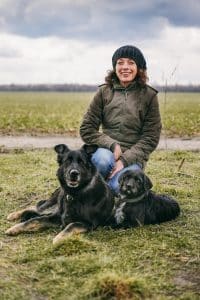
My name is Anja Boecker, and I am a certified dog trainer and behavior consultant. With these articles, I want to help you to understand your dog better and to build an inseparable bond.
Share Now:

